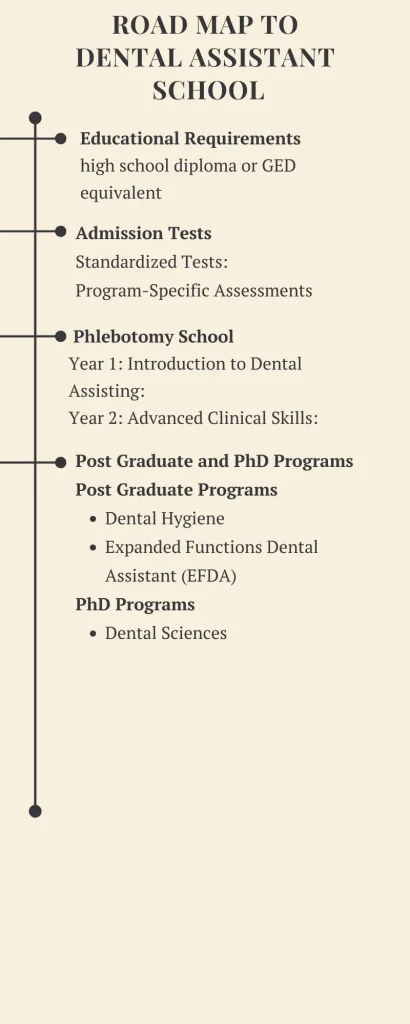How Long is Dental Assistant School
How long is dental assistant school? The duration varies, typically ranging from 9 months to 2 years. Certificate programs often take around 9-12 months, while associate degree programs may require up to 2 years. The program length depends on the specific curriculum and whether you attend full-time or part-time.
What is Dental Assistant School
Dental assistant school prepares students for a career in dental assisting by providing comprehensive training in dental procedures, patient care, and administrative tasks. The curriculum typically includes courses in dental anatomy, radiography, infection control, and chairside assisting. Hands-on clinical experience is a crucial component, allowing students to apply their knowledge in real-world dental settings.

In addition to technical skills, dental assistant programs often emphasize the development of soft skills such as communication, teamwork, and patient management. Graduates of dental assistant school are equipped to perform a variety of tasks, including taking dental impressions, sterilizing instruments, and assisting dentists during procedures. This training ensures that dental assistants are well-prepared to support dental practices and enhance patient care
How Long is Dental Assistant School
1st Year: Introduction to Dental Assisting:
Introduction to Dental Assisting: Courses covering dental terminology, basic dental sciences, and introductory dental procedures.
Preclinical Training: Hands-on practice with dental instruments, radiography techniques, and basic chairside assisting skills.
2nd Year: Advanced Clinical Skills
Advanced Clinical Skills: In-depth training on advanced dental procedures, expanded functions, and patient care techniques.
Externship/Clinical Rotation: Real-world experience in dental offices or clinics, applying learned skills in patient care and dental office operations.

HOW TO ENTER DENTAL ASSISTANT SCHOOL
Educational Requirements
High School Diploma or GED: Essential for entry into most dental assistant programs.
Prerequisite Courses: Basic courses in biology, chemistry, and anatomy may be required.
Entry Tests
Standardized Tests: Some programs might require standardized test scores (like the SAT or ACT) for admission.
Program-Specific Assessments: Certain schools may have their own entrance exams or placement tests to evaluate applicants’ readiness.
Application Process
Research and Choose Programs: Identify accredited dental assistant programs that meet your needs.
Complete Application Forms: Fill out application forms, either online or in paper format.
Submit Transcripts: Provide high school transcripts and any relevant college coursework.
Letters of Recommendation: Obtain recommendations from teachers, employers, or mentors.
Personal Statement: Write a statement of purpose or personal essay, if required.
Interview: Attend an interview if the program requires it.
Financial Aids
Scholarships: Look for scholarships specific to dental assisting, offered by schools, professional organizations, or private foundations.
Grants: Apply for federal and state grants, such as the Pell Grant, which do not require repayment.
Loans: Consider federal student loans or private loans to cover tuition and related expenses.
Work-Study Programs: Explore work-study opportunities that provide financial assistance in exchange for part-time work.
Tuition Reimbursement: Some employers may offer tuition reimbursement for employees pursuing a dental assisting education.
This detailed outline ensures you understand the various aspects of entering and completing a dental assistant program, including the time commitment, academic requirements, and available financial resources.
Post Graduate and PhD Programs for Dental Assistant School
Postgraduate Programs:
Dental Hygiene: Many dental assistants pursue further education to become dental hygienists, requiring an associate’s or bachelor’s degree.
Expanded Functions Dental Assistant (EFDA): Postgraduate certifications allow dental assistants to perform more advanced duties.
Specialty Certifications: Programs in orthodontics, oral surgery, pediatric dentistry, and more.
PhD Programs:
Dental Sciences: Focus on research, teaching, and advanced clinical practice. PhD programs are typically not direct extensions of dental assisting but can be pursued by those interested in advanced dental research or education.
Top 10 Dental Assistant Schools

- New York University (NYU) College of Dentistry:
Offers comprehensive dental assistant programs with hands-on clinical training.
- University of Southern California (USC) School of Dentistry:
Known for its rigorous curriculum and state-of-the-art facilities.
- University of North Carolina at Chapel Hill School of Dentistry:
Provides a strong emphasis on both academic and practical skills.
- University of Michigan School of Dentistry:
Offers excellent clinical training opportunities and a robust educational framework.
- Ohio State University College of Dentistry:
Known for its high-quality training and extensive clinical practice.
- Boston University Henry M. Goldman School of Dental Medicine:
Offers innovative programs and access to cutting-edge dental technology.
- University of Pennsylvania School of Dental Medicine:
Provides comprehensive training with a focus on advanced dental practices.
- University of Minnesota School of Dentistry:
Known for its strong clinical training and research opportunities.
- University of Washington School of Dentistry:
Offers extensive clinical experience and a focus on patient-centered care.
- Loma Linda University School of Dentistry:
Known for its holistic approach to dental education and strong clinical training programs.
These schools are recognized for their exceptional programs, state-of-the-art facilities, and comprehensive training that prepares students for successful careers as dental assistants.
Factors Affecting the Length of Dental Assistant School
1. Program Type:
Certificate Programs: Typically last 9-12 months and focus on core skills.
Associate Degree Programs: Usually take 18-24 months and include general education courses alongside dental-specific training.
2. Full-Time vs. Part-Time Enrollment:
Full-Time: Allows students to complete the program in the shortest time possible.
Part-Time: Offers flexibility for those balancing other commitments but extends the duration of the program.
3. Clinical Training Requirements:
Externships/Internships: Some programs require extensive hands-on clinical training, which can lengthen the time needed to complete the program.
4. Curriculum Structure:
Accelerated Programs: Some schools offer accelerated tracks that condense coursework into a shorter period.
Traditional Programs: Follow a standard academic schedule with breaks and vacation periods.
5. Prerequisites:
Completed Before Enrollment: Some programs require students to complete certain courses beforehand, which can affect the overall time to completion.
Included in Program: Others include prerequisite coursework within the program, potentially extending the length.
6. State Requirements:
Licensing and Certification: Varies by state; some states have specific educational requirements that can influence the program length.
Continuing Education: Ongoing education requirements may also impact the initial training duration.
7. School Resources and Facilities:
Availability of Training Resources: Access to necessary tools and facilities can affect how quickly students can progress through practical components.
Faculty Availability: The ratio of instructors to students can influence the pace at which practical skills are taught and assessed.
8. Online vs. On-Campus Programs:
Online Programs: May offer more flexible scheduling, potentially speeding up or slowing down the completion time depending on the student’s pace.
On-Campus Programs: Follow a more structured timeline, which may be less flexible.
Understanding these factors can help prospective students choose the dental assistant program that best fits their needs and timelines.
Final Verdict
The length of dental assistant school varies based on program type, enrollment status, and other factors. By understanding these elements, prospective students can make informed decisions about their education path, ensuring they choose a program that fits their career goals and personal circumstances.
FAQs
1. How long is dental assistant school?
Dental assistant programs typically range from 9 months for certificate programs to 2 years for associate degree programs.
2. What are the prerequisites for dental assistant school?
Most programs require a high school diploma or GED and may have additional prerequisites like courses in biology and chemistry.
3. Are there online dental assistant programs?
Yes, many schools offer online or hybrid programs that combine online coursework with in-person clinical training.
4. What is the difference between a certificate and an associate degree in dental assisting?
Certificate programs are shorter and focus on core dental assisting skills, while associate degree programs include general education courses and provide a broader educational experience.
5. Can I work while attending dental assistant school?
Many programs offer part-time or flexible scheduling options, allowing students to work while completing their education.
